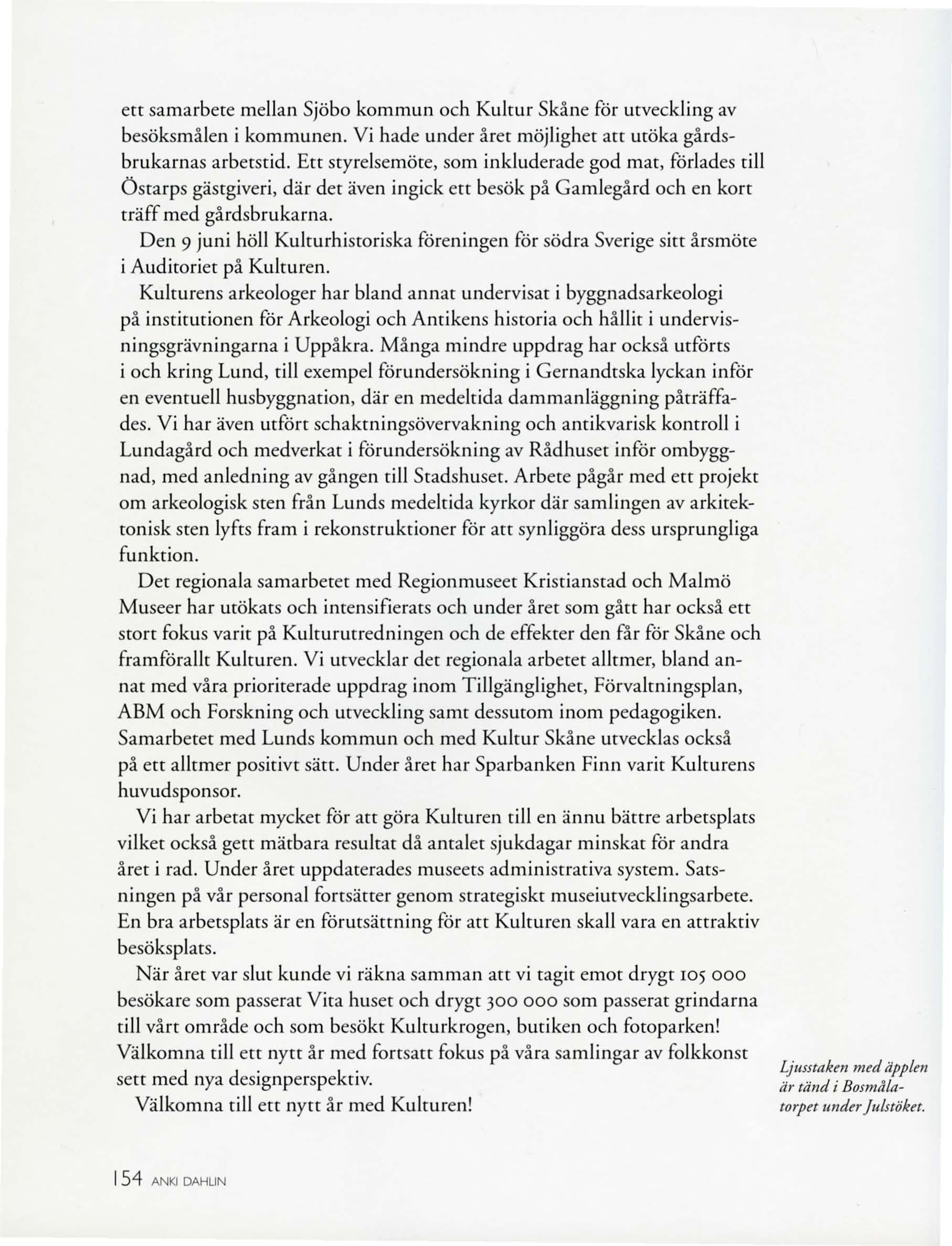
10 minute read
SUMMARIES IN ENGLISH
by Kulturen
ett samarbete mellan Sjöbo kommun och Kultur Skåne för utveckling av besöksmålen i kommunen. Vi hade under året möjlighet att utöka gårdsbrukarnas arbetstid. Ett styrelsemöte, som inkluderade god mat, förlades till Öscarps gästgiveri, där det även ingick ett besök på Gamlegård och en kort träff med gårdsbrukarna.
Den 9 juni höll Kulturhistoriska föreningen för södra Sverige sitt årsmöte i Auditoriet på Kulturen.
Kulturens arkeologer har bland annat undervisar i byggnadsarkeologi på institutionen för Arkeologi och Antikens historia och hållit i undervisningsgrävningarna i Uppåkra. Många mindre uppdrag har också utföres i och kring Lund, till exempel förundersökning i Gernandcska lyckan inför en eventuell husbyggnacion, där en medelcida dammanläggning påträffades. Vi har även utfört schakcningsövervakning och antikvarisk kontroll i Lundagård och medverkat i förundersökning av Rådhuset inför ombyggnad, med anledning av gången till Stadshuset. Arbete pågår med ett projekt om arkeologisk scen från Lunds medeltida kyrkor där samlingen av arkitektonisk scen lyfts fram i rekonstruktioner för att synliggöra dess ursprungliga funktion.
Det regionala samarbetet med Regionmuseet Kristianstad och Malmö Museer har utökats och intensifierats och under året som gått har också ett stort fokus varit på Kulcurucredningen och de effekter den får för Skåne och framförallt Kulturen. Vi utvecklar det regionala arbetet alltmer, bland annat med våra prioriterade uppdrag inom Tillgänglighet, Förvalcningsplan, ABM och Forskning och utveckling same dessutom inom pedagogiken. Samarbetet med Lunds kommun och med Kultur Skåne utvecklas också på ett alltmer positive sätt. Under året har Sparbanken Finn varit Kulturens huvudsponsor.
Vi har arbetat mycket för att göra Kulcuren till en ännu bättre arbetsplats vilket också gett mätbara resultat då antalet sjukdagar minskat för andra året i rad. Under året uppdaterades museets administrativa system. Satsningen på vår personal fortsätter genom strategiske museiucvecklingsarbece. En bra arbetsplats är en förutsättning för att Kulturen skall vara en attraktiv besöksplacs.
När året var slut kunde vi räkna samman att vi tagit emot dryge 105 ooo besökare som passerat Vita huset och dryge 300 ooo som passerat grindarna till vårt område och som besökt Kulturkrogen, butiken och fotoparken! Välkomna till ett nytt år med forcsatt fokus på våra samlingar av folkkonst sett med nya designperspekciv.
Välkomna till ert nytt år med Kulturen!
l j 11sst11ke11 med äpplen iir tiind i Bosmålatorpet 1111der }11lstöket.

DESIGNING WHILE MAINTAINING A SENSE OF FOLK
Anna-Stina Linden !varsson What happens when rrained designers tackle folk art? Anna-Stina Linden Ivarsson met Bengt Lindberg, Lotta Glave and Katarina Brieditis - three contemporary designers who all have their roots in folk art.
Bengt Lindberg's maternal grandparems had a farm in Skåne -a home filled wirh old objecrs, a lor of rustic folk art. This is where his design roots can be found, he says. Lotta Glave comes from Malmö but does not proceed from the Scanian tradition; instead she is inspired by Austrian folk art as passed on by her morher's family. Bengt and Lotta have often sketched and worked on the same product. They bandy ideas back and forth. "It shouldn't be visible who did what. Everything should look as if it came from the same family."
IfKatarina Briediris had received royalties for the folk-inspired products, over a hundred of them, that she designed for Ikea at the end of the 199os, she would have been horribly rich roday. The handembroidered cushion Alfhild Fågelwas incredibly popular. Bur it was not emirely easy for Katarina Brieditis ro work wirh a folk expression: "My desire and intention with the collection was ro be like a missionary spreading rhe word about domestic handicraft and all the knowledge rhat exists there. To get people ro open their eyes ro it. But sometimes I got the feeling rhar people thought that I was like a parasite commercializing the cultural herirage."
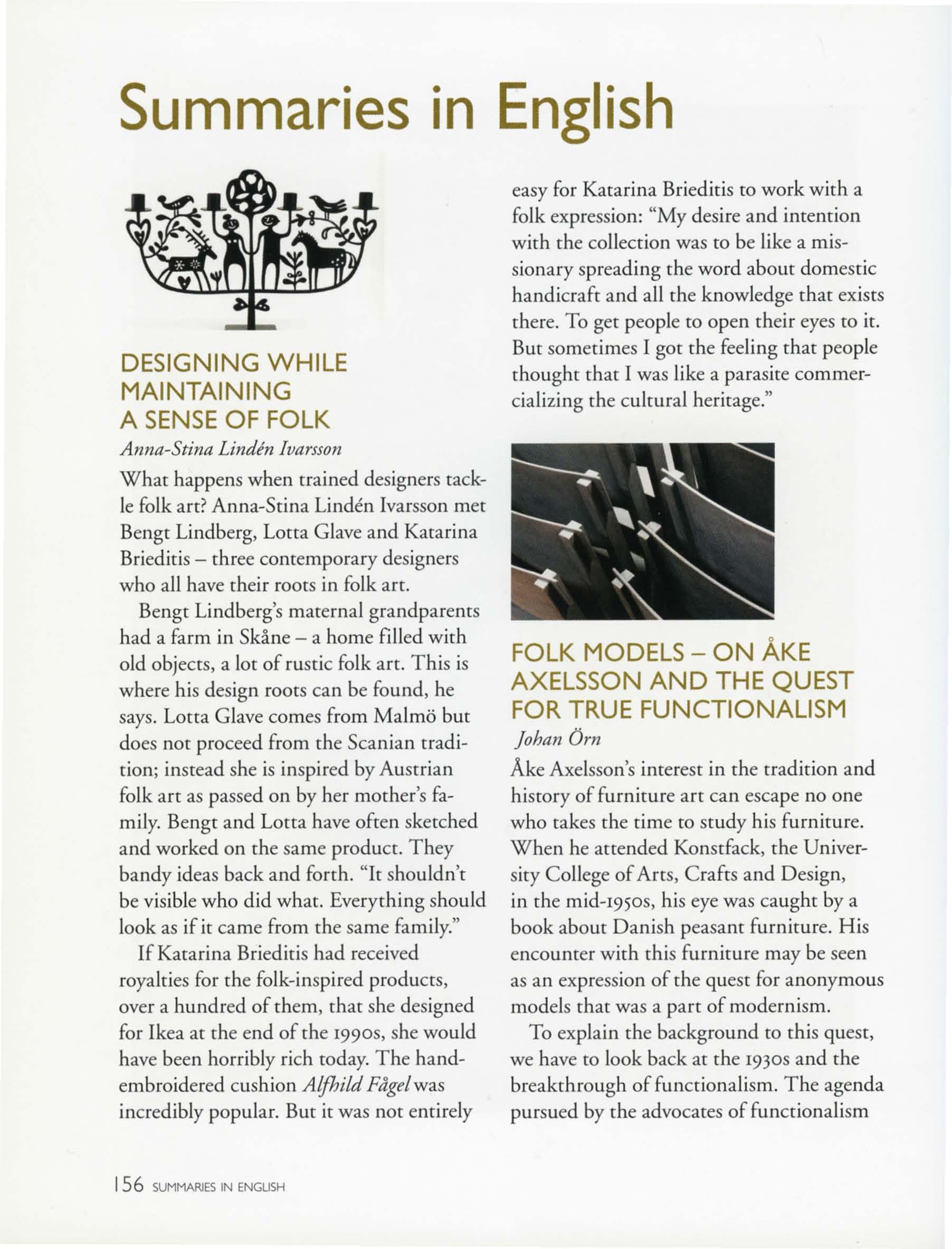
FOLK MODELS - ON ÅKE AXELSSON AND THE QUEST FOR TRUE FUNCTIONALISM
Johan Örn Åke Axelsson's inreresr in rhe tradition and hisrory of furniture art can escape no one who rakes the time ro study his furniture. When he attended Konstfack, the University College of Arts, Crafts and Design, in the mid-195os, his eye was caught by a book about Danish peasam furniture. His encoumer wirh this furniture may be seen as an expression of the quest for anonymous models that was a part of modernism.
To explain the background ro rhis quest, we have ro look back at the 193os and the breakthrough of functionalism. The agenda pursued by the advocates of funcrionalism
included curcing the ties ro hisrory. In the field of furnirure this meam, ro simplify matcers, abandoning hisrorical references and the tendency ro think in stylistic terms. Tubular steel furniture became the sign of the new ideal, even though it did not dominate the major propaganda exhibition of functionalism, the Stockholm Exhibition of 1930. In the middle of that decade, this ideal came under debate. It was argued that the rubular steel furnirure and the cubic and right-angled fashion simply did not represent true functionalism. It has its roots furrher back in time, in the anonymous folk furniture culrure.
There was a belief that the slowly emerging types of folk culrure could show the direction away from the artificial design ideals of the time. The quest for modds outside the field that is reckoned as the established styles of furniture hisrory can be found in the work of many imerior designers in the subsequem decades. ourlooks are concealed behind the ornate, grandiose, sometimes clumsy marks. We know abour some of rhem, bur most of them are unknown.
On folk objects the initials usually consist of three lercers, ending with either S for son or D for daughter. For example, EAS, Erik Andersson, or AND, Anna Nilsdorcer.
The catalogue cards for the objects do not provide much personal hisrory. They are dominated by information about materials and techniques. Who, for example, were the SNS and AND on the blue cupboard and what happened ro them on 29 September 1835? We have ro use our imagination.
It is popular roday ro think abour one's own pastor other people's lives, not just among elderly genealogists. If it amuses you ro look backwards and look for links, clues such as initials on an old scutching knife, an embroidered carriage cushion, or a tatroo can lead ro imaginative interpretations and new insights.
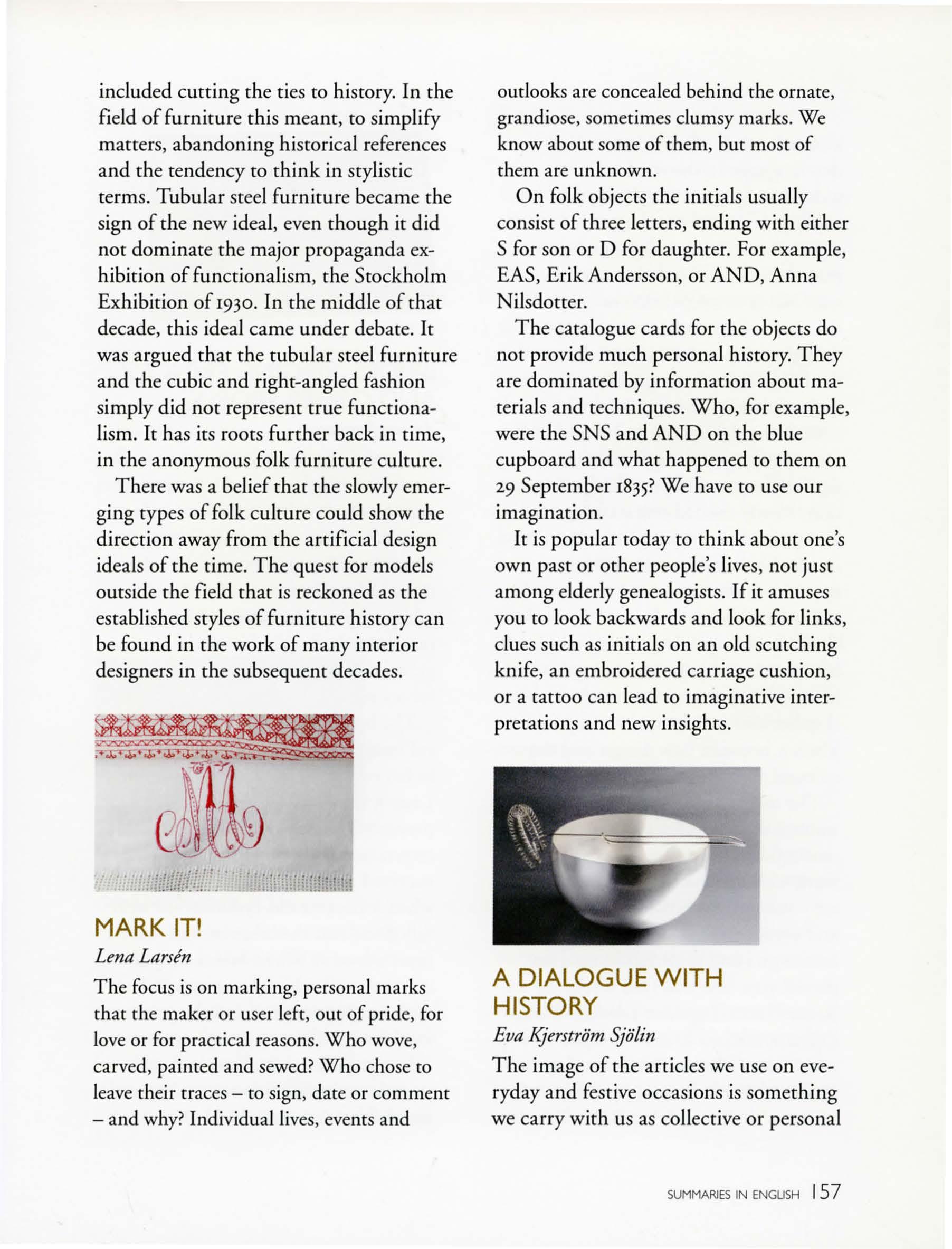
MARK IT!
Lena Larsen The focus is on marking, personal marks that the maker or user lefr, our of pride, for love or for practical reasons. Who wove, carved, painted and sewed? Who chose ro leave their traces - ro sign, date or comment - and why? Individual lives, events and
A DIALOGUE WITH HISTORY
Eva Kjerström Sjölin The image of the arricles we use on everyday and festive occasions is something we carry with us as collective or personal
memories. It is ofcen chere as a hidden language in che works of many of roday's designers, artists and crafcsmen.
The form, che cechnique and che material are used in a new, unexpecced way. Never as a repetition or copy of che old, bur as a resulc of conscious choughc, of quesrions of new design and che folk-culcure hericage, of communicacion, idencicy and memory.
Colleccively experienced or personal memory is che driving force. Folk design and expression provide che inspiration. Newly creaced objeccs are artiscic interpretations, which give us keys ro see che hisrorical material wich new eyes.
Eleven Swedish artists and cheir works have been selecced here precisely because chey engage in a dialogue wich hisrory. They engage in che relacionship becween newly made chings and hisrory, becween new design and che culcural hericage.
The artistsarea mix of men and women 38 ro 85 years old, chus represencing differenc generations. They work wich different kinds of applied art - cexciles, ceramics, silver, glass and woodcarving. Some of chem mix cechniques and materials in an unexpecced way. You will fi nd works by Raine Navin, Ingalena Klenell, Wanja Djanaieff, Klara Eriksson, Signe Persson-Melin, T homas Anagrius, Ingela Karlsson, Karin Ferner, Macz Nordell, Mårten Medbo and Anna Atterling.
BRIDES, VIRGINS, PRINCESSES AND OTHER PEOPLE
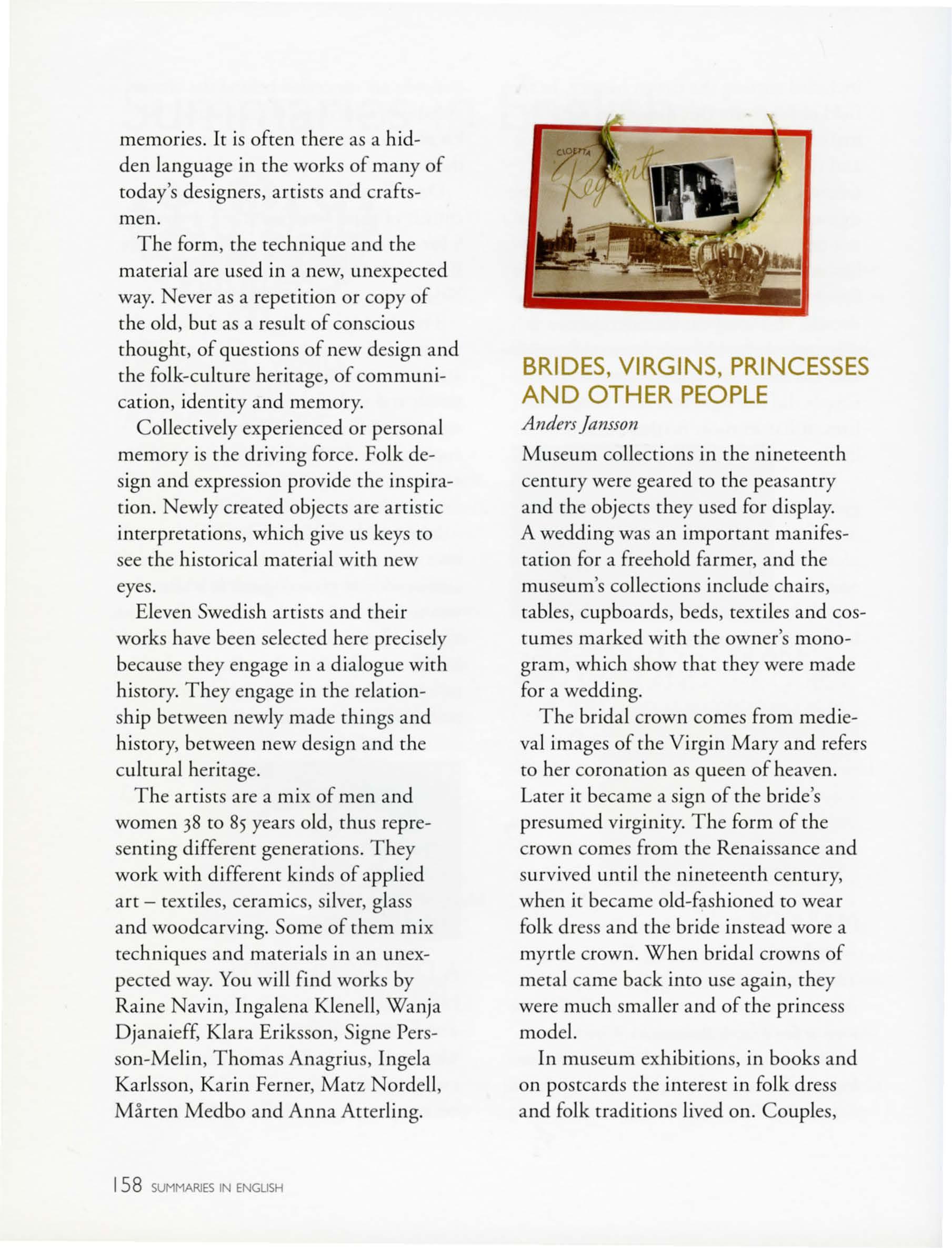
Anders Jansson Museum colleccions in che nineceench cencury were geared ro che peasancry and che objeccs chey used for display. A wedding was an importanc manifestation for a freehold farmer, and che museum's colleccions include chairs, rabies, cupboards, beds, cexciles and coscumes marked wich che owner's monogram, which show chac chey were made for a wedding.
The bridal crown comes from medieval images of the Virgin Mary and refers ro her coronacion as queen of heaven. Later it became a sign of che bride's presumed virginicy. The form of che crown comes from che Renaissance and survived uncil che nineceench cencury, when it became old-fashioned ro wear folk dress and che bride inscead wore a myrde crown. When bridal crowns of mera! came back inco use again, chey were much smaller and of che princess mode!.
In museum exhibicions, in books and on posccards che inceresc in folk dress and folk traditions lived on. Couples,
mosdy rhe bride, in rhe rwentierh cenrury sometimes chose folk dress for rheir weddings, bur now in a modified and modernized form.
Even in rhe ninereenth century rhere were many people who did not ger married in church. The wedding was held in rhe home or rhe vicarage, and in modern rimes ourdoor weddings have become common again. Civil marriage was introduced in 1908, and an acr on samesex marriage was passed in 2009.
For rhe museum it is important ro reflect as much as possible of hisrory, not just rhe visible bur also rhe invisible, not just rhe ordinary bur also rhe exrraordinary. Weddings wirhour phorographs as well as weddings wirh lots of picrures. Tradition has irs roors in hisrory, bur it is consrandy changing.
- ' \'jiJI .. _ ... . ( - ,- . ,.,.. t • ' · , • ,._, . 'I '· •• I , .. '·. ".,. . • . .. I ••• J .•• ... • , . ,.....,..
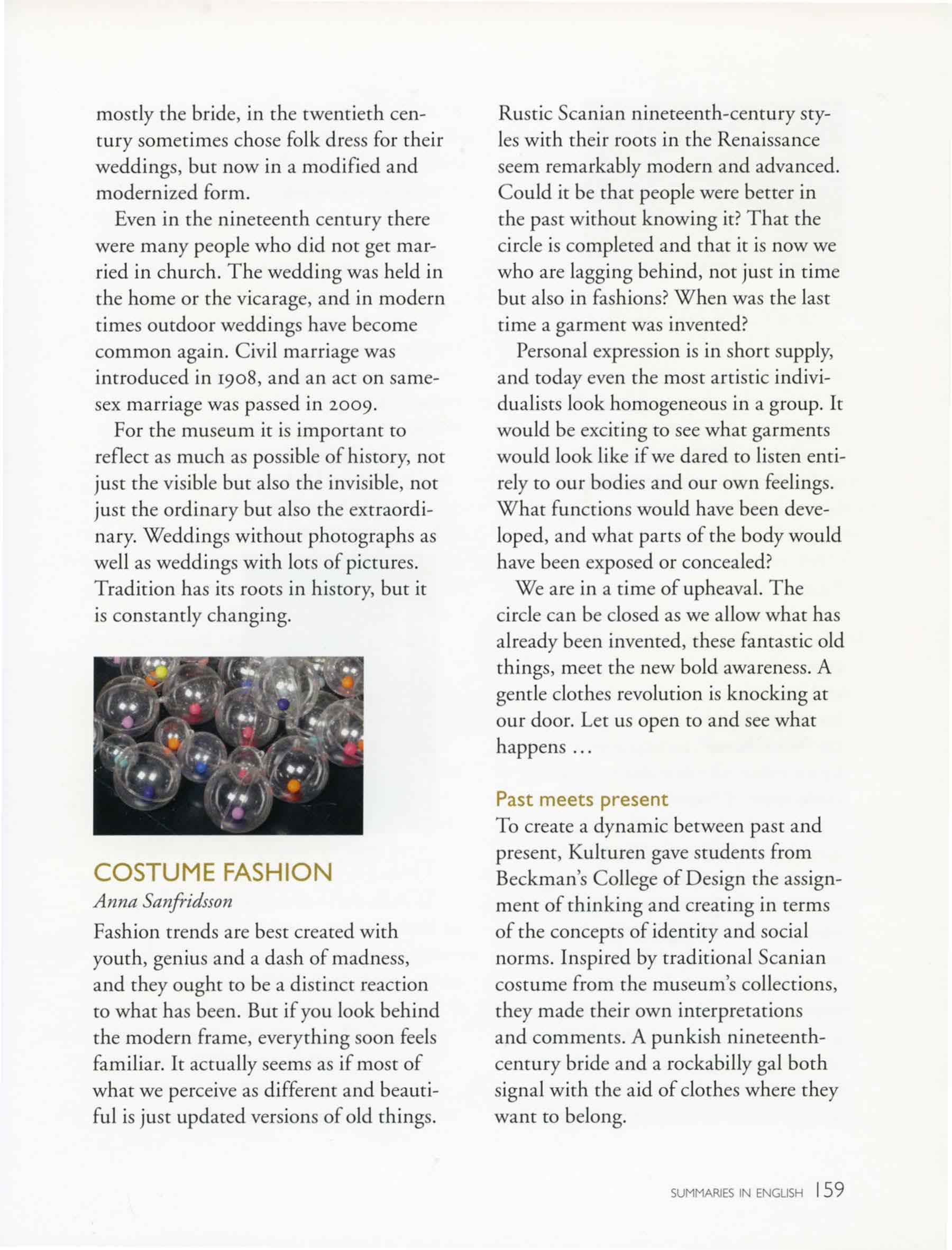
'•, - • • .. , '•I I •• • , . ,, •• · l,•• ,. .r. . J . . .... ! ··.<· ·. t, "": ,. . : ,· ••·,) •• "' .., I•• • ' ) . -
COSTUME FASHION
Anna Sanfridsson Fashion trends are best creared wirh yourh, genius and a dash of madness, and rhey oughr ro be a disrincr reacrion ro whar has been. Bur if you look behind rhe modern frame, everyrhing soon feels familiar. It acrually seems as if mosr of what we perceive as differenr and beauriful is just updared versions of old rhings. Rusric Scanian ninereenth-century styles wirh rheir roots in rhe Renaissance seem remarkably modern and advanced. Could it be rhar people were better in rhe pasr without knowing it? That the circle is complered and rhat it is now we who are lagging behind, not just in rime bur also in fashions? When was rhe last time a garment was invented?
Personal expression is in shorr supply, and roday even the most artistic individualists look homogeneous in a group. It would be exciting ro see what garments would look like if we dared ro listen entirely ro our bodies and our own feelings. Whar functions would have been developed, and what pares of rhe body would have been exposed or concealed?
We are in a rime of upheaval. The circle can be closed as we allow what has already been invented, rhese fantasric old rhings, meer rhe new bold awareness. A gende clorhes revolution is knocking ar our door. Ler us open ro and see what happens ...
Past meets present To creare a dynamic berween past and present, Kulturen gave students from Beckman's College of Design the assignment of rhinking and creating in terms of rhe conceprs of identity and social norms. Inspired by rradirional Scanian cosrume from rhe museum's collections, rhey made rheir own interpretations and comments. A punkish nineteenthcentury bride and a rockabilly gal both signal wirh rhe aid of clorhes where rhey want ro belong.








